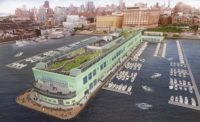Billion-Dollar Makeover Set For Famous New York Bridge

A full-body rehabilitation program for the venerable George Washington Bridge over the Hudson River is ramping up—literally.
The Port Authority of New York & New Jersey has begun engineering for three rehabilitation projects totaling about $500 million, including a $218-million reconstruction of street and bus ramps linking to the 4,760-ft-long, double-level 14-lane structure. Late last year, the agency approved a $15.5-million investment in repair work on the suspender ropes—the beginning stage of that estimated $1-billion project.
Also, American Bridge Co., Coraopolis, Pa., is in full swing on its $80-million contract to replace orthotropic deck sections of the upper roadway of the bridge, which carries 106 million vehicles annually. "It's like Las Vegas around here—there's always something happening," says Andrea Giorgi Bocker, the GWB's engineer of construction for the port authority. "The bridge is 80 years old now, and it's time to look at everything and fund these major projects."
Made possible by a toll increase authorized in August 2011, the three recently announced rehab projects also will replace 130,000 sq ft of two street ramps and five related bus ramps, says Stewart Sloane, principal structural engineer for the agency. The ramps will be seismically upgraded with reinforcements for the piers and upgraded bearings. "We're just about to start final design," says Sloane. "We plan to put out one contract for all five structures in 2013."
The second of the three projects focuses on upgrades to two 450-ft-long bridges that cross over the bridge's New Jersey Interstate 95 approach. Three of seven spans for the Lemoine Avenue Bridge will be redecked with reinforced concrete, says Sloane, as will all seven nearby Center Avenue Bridge spans.
Rehabilitation of the bridge's six-lane lower level is in preliminary planning, says Bocker. The estimated $200-million job will include lead paint removal, repainting, steel repairs and new travelers. "It will be heavy-duty work, but it's on the underside," so future crews should have less issues with traffic, Bocker adds. Request for proposals may be ready by the end of the year, says Bernie Yostpille, the agency's assistant chief structural engineer. A contract is anticipated in 2014.
Repair work on nearly 600 suspender ropes is expected to begin in 2013 and last eight to nine years, since a maximum of three suspender ropes can be replaced at a time. Work will entail rehabilitating the four main cables and anchorages, relocating two sidewalks along their entire lengths and replacing the necklace lighting attached to the main cables.
A team conducting final design for that work is being led by Ammann & Whitney, the New York City-based firm founded by the renowned designer Othmar Ammann.
The GWB was once the longest suspension bridge in the world, notes Peter Sluszka, Ammann & Whitney vice president. "It was a fantastic accomplishment, in 1931, to spin 3,500-ft-long main cables, each 36 in. in diameter and containing 26,000-plus wires divided into 61 strands," he says. "The wires were dragged across the bridge from anchorage to anchorage with a spinning wheel."
The suspender ropes each contain almost 300 wires. Generally, wire rehab includes replacing the outer coating with a new paste and waterproofing it, Sluszka says. The best protection, a standard practice in Japan, is to inject dry air into the cables, dehumidify them and then allow the air to escape at certain points, he adds. That could be a possibility for the GWB.
In my opinion what was most fantastic about the events surrounding the building of the George Washington Bridge is the fact that it was permissible to bid on an alternative design that ...
hinged at the ends instead of cables. It was great good fortune that this bid was higher than the cable alternative.
Naturally I can only speak for myself, but the fact that the George Washington was once the longest
bridge in the world does not make it especially interesting from an innovative engineering point of view. Roebling was the great pioneer in his beautiful innovation of spinning cables using a traveling wheel that carried the wires from shore to shore to build up the cables, and we now know that the George Washington Bridge was underdesigned against wind.
By 1931 enough was known about corrosion and the technology of injecting dry air and dehumidifying and sealing was technologically easy so the practice of Japanese Bridge Engineers
today could have been done by American Bridge Engineers in 1931. Corrosion of cables especially
at the anchorages is a real problem and it was by luck as well as anything else that this was discovered in time.
I believe the real glory of great bridges like the George Washington is that they were built economically and by today's standards really fast.These accomplishments should not be slighted
although the "Sunday Supplements" naturally would dwell on their record breaking spans.



_ENRreadyCover.jpg?height=200&t=1646347837&width=200)